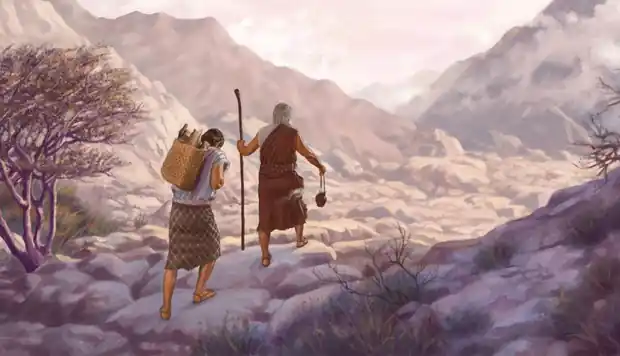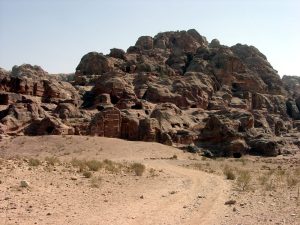This study would be nothing more than an exercise in history if God hadn’t taken a personal interest in the moon-god and his worshipers—namely, the Amorites. Remember, God called them out specifically when He made his covenant with Abraham.
The moon-god, under various names, was of supreme importance to Amorites in general, and especially to those of Babylon and Canaan.
It shouldn’t be a surprise that the Amorites and their gods tried to interfere with God’s plan for His people right from the Book of Genesis. After God divided the nations at Babel “according to the number of the sons of God,”[1] He chose Abraham to establish a new people as “His allotted heritage.”[2]
So, the principalities and powers, who were no doubt watching Yahweh’s every move, took note when He directed Abraham to Canaan and miraculously intervened on behalf of his nephew, Lot—especially after Abraham and his 318 retainers successfully raided the army of the kings of the east who’d just defeated the Rephaim tribes living in the Transjordan.
They must have been very interested when God miraculously blessed the aged Abraham and Sarah with Isaac. Suddenly, now, the promise of offspring who would be “as the stars of heaven”[3] was a real possibility.

Then things took a strange turn: God told Abraham to take Isaac to the land of Moriah and sacrifice him as a burnt offering.
You have to wonder what was in the minds of the Fallen at this point—after all, human sacrifice was their turf. The detestable rite has been practiced on every continent except Antarctica, but Yahweh had made it clear to Noah that shedding human blood was forbidden.[4] Sacrificing and burning children as an offering to the gods was even more offensive to God.[5] Yet there was Abraham, with Isaac tied up on a pile of wood, ready to plunge a knife into his only son.
It was a test, shocking to us modern Christians. Why would Abraham even listen to a God who demanded such a thing? Well, the world was a lot different then. Human sacrifice was a reality in the world of the Amorites. Archaeologists have found children ritually slaughtered at a number of Amorite sites during the time of Abraham.[6]
Their Sumerian and Egyptian predecessors likewise practiced it; “retainer sacrifice,” the ritual murder of the servants of kings and nobles who’d died, is well documented in the tombs of ancient Ur and the kings of Egypt’s First Dynasty. So, it wouldn’t have been unusual for a god to demand the sacrifice of a loved one in Abraham’s day.
Here’s another significant part of the story: Some scholars believe “the land of Moriah” was “the land of the Amorites,” with the name Amurru losing its first syllable over time the way English-speakers shorten “until” to “till,” a phenomenon called “aphesis.” Connecting Moriah to the Amorites was apparently in the minds of the Jewish translators of the Septuagint, who rendered it from Hebrew into Greek in 2 Chronicles 3:1 as Ἀμωρία—Amōriā.
Why does this matter? Because Mount Moriah, the Mountain of the Amorites, is where David bought the threshing floor of Araunah, upon which Solomon built the Temple. In other words, Mount Moriah is the Temple Mount—Zion.
Have you ever noticed that it was on the third day when Abraham saw the place God had appointed for His message to the rebel spirits?[7] No Christian can miss the symbolic significance of that detail.
That’s where Armageddon will be fought. God staked His claim to that mountain in the nineteenth century BC when He stopped Abraham from harming Isaac in the heartland of the Amorites.
Yahweh telegraphed the coming battle for the land occupied by the moon-god’s followers sometime between 1840 and 1830 BC. Isaac was born around 1851 BC, but since Abraham asked his son to carry the wood up to Mount Moriah, Isaac wasn’t a small child when they traveled to the land of the Amorites.
Four hundred years later, when the Israelites were freed from their oppressors in Egypt, the battle was officially on.
They set out from Elim, and all the congregation of the people of Israel came to the wilderness of Sin, which is between Elim and Sinai, on the fifteenth day of the second month after they had departed from the land of Egypt.
Exodus 16:1 (ESV)
It’s important to remember that there are no throwaway details in the Bible. The prophets and apostles didn’t add things for just for color, drama, or word count. So, what do we take away from this passage?
Elim is probably in the Wadi Gharandel, a normally dry riverbed in the western Sinai. The Wilderness of Sin must have been the desert that covers the center of the Sinai Peninsula. Now, why would Moses record the specific day of the month when the people entered this wilderness? And what’s the significance of the fifteenth day?
In the ancient Near East, the calendar was based on the cycles of the moon. The fifteenth day was the time the moon was full—meaning the moon-god was at full strength.
Does the name of the desert suddenly make sense?
Yes, the Wilderness of Sîn. That Sîn. The Wilderness of the Moon-god.[8]
The reasons behind the name of the desert should be apparent. In a land where daytime temperatures in the summer average 97 degrees Fahrenheit (36 Celsius), one travels at night whenever possible. Since the moon’s predictable changes coincide with fertility cycles, which were important to both humans and herds, the moon-god’s movement through the sky guided the lives of the pastoral nomads who traveled through the wilderness of Sîn.
Just as He did at the Red Sea, Yahweh led Israel on a specific route—in this case, at a specific time—to confront the small-g gods who’d rebelled against His authority.
Not surprisingly, the people complained.
And the whole congregation of the people of Israel grumbled against Moses and Aaron in the wilderness, and the people of Israel said to them, “Would that we had died by the hand of the Lord in the land of Egypt, when we sat by the meat pots and ate bread to the full, for you have brought us out into this wilderness to kill this whole assembly with hunger.”
Exodus 16:2–3 (ESV)
Is it any wonder they grumbled? Moses led them into a land named for one of the most powerful gods of the Amorites on a day when the god was at full strength! They’d already learned how difficult it was to find water in this land; they were three days out from the Red Sea before they found the waters of Marah—and even then, divine intervention was required to make the water drinkable.
How did God respond? The morning after Israel entered the Wilderness of Sîn, when the moon-god was believed to be at full power, Yahweh caused bread to rain down from heaven.[9]
Coincidence? No. It was another demonstration of His power over the supernatural realm, especially over the bene elohim who’d dared to set themselves up as gods. The manna fell from heaven for Israel until the day they crossed the Jordan forty years later.
Here’s another paradigm-shifter: Have you ever considered that Sinai, “the mountain of God” where Moses saw the burning bush, was named for the moon-god? Neither did I. But this isn’t a new idea; scholars have believed that the Mesopotamian moon-god was the origin of the name “Sinai” for more than a hundred years.[10] So, this showdown between Yahweh and Sîn in the middle of the Sinai was more than forty years in the making.
Think about this: It was on the mountain of the moon-god where Yahweh revealed Himself to Moses and where He shared with Moses that His Name was Yahweh.
Then Moses said to God, “If I come to the people of Israel and say to them, ‘The God of your fathers has sent me to you,’ and they ask me, ‘What is his name?’ what shall I say to them?” God said to Moses, “I am who I am.” And he said, “Say this to the people of Israel: ‘I am has sent me to you.’” God also said to Moses, “Say this to the people of Israel: ‘The Lord, the God of your fathers, the God of Abraham, the God of Isaac, and the God of Jacob, has sent me to you.’ This is my name forever, and thus I am to be remembered throughout all generations.”
Exodus 3:13–15 (ESV)
God spoke to Moses and said to him, “I am the Lord. I appeared to Abraham, to Isaac, and to Jacob, as God Almighty, but by my name the Lord I did not make myself known to them.”
Exodus 6:2–3 (ESV)
In other words, “I am Yahweh. I appeared to Abraham, to Isaac, and to Jacob, as El Shaddai, but by my name Yahweh I did not make myself known to them.”

So, what does El Shaddai mean? Most probably, “God of the mountains.”[11] Some scholars have assumed that this title was originally applied to the Canaanite creator-god, El. After all, his mount of assembly was Mount Hermon,[12] the most impressive peak in the Near East.
The Amorites, who were considered uncultured mountaineers by the city-dwelling Sumerians, were represented in the Mesopotamian pantheon by an uncivilized god called Amurru. One of the epithets of Amurru was Bêl Šadê, which is Akkadian for “lord of the mountains.”[13] Because you’re observant, you probably noticed the similarity between Bêl Šadê and El Shaddai right off. (The funny-looking š is pronounced “sh.”) Because of this, some scholars believe Amurru was the Amorite original on which the later Hebrews modeled Yahweh.
Of course, that requires believing Moses more or less invented Hebrew religion, an idea we reject. If Jesus, who healed the sick, cast out demons by His own authority, walked on water, and prophesied His own Resurrection, was wrong about Moses, then you and I are in a world of trouble.
But there’s another possibility, and it supports our theory that the moon-god was far more important in the ancient world than we realize. Amurru, which refers to the Amorites as well as to the god of that name, may have been an epithet rather than a proper name.
Instead of “Amurru” being a god who shared the name of the Amorite people, it may have been a title of the moon-god: “Sîn, god of the Amurru-land.”
There is substantial evidence to support the identification of Bêl Šadê, the god of the Amurru-land, with a lunar deity, specifically with Sîn. (1) Harran, from at least the Middle Bronze period until the late Middle Ages, was regarded as a major sanctuary of the moon-god Sîn. And we know in particular that the Amurru-peoples concluded treaties in his temple during the Mari period. (2) There are a number of seal cylinders on which the god Amurru, recognizable by inscription, curved staff, and sacred gazelle, is shown standing under a lunar crescent. If this is felt insufficient to establish his lunar nature, the fact that he sometimes holds or stands before a cult standard atop which is a crescent certainly strongly suggests it. (3) Once we find the sacred staff of the god Amurru on the seal of a devotee of the god Sîn. The inscription reads: E-til-pi4-Ištar…arad dSîn. (4) Several individuals with theophoric names of the Sîn-type describe themselves on their seals as servants of the god Amurru.
We may reasonably conclude, therefore, that the god worshiped by the nomadic Amurru-peoples in the Balikh-Harran region by the epithets “Amurru” and “Bêl Šadê,” at the time of the Mari and Old Babylonian texts, was a lunar deity. Sometimes he is specifically named (or at least identified with) Sîn.[14]
The Balikh-Harran region is precisely where Abraham began his journey to Canaan. In other words, in Abraham’s homeland the moon-god was “lord of the mountains.”
Is it surprising, then, that Yahweh revealed Himself to the patriarchs as the true God of the mountains, El Shaddai, and that Moses would have his first encounter with Yahweh at har hāʾĕlōhîm, the “mountain of God”?
[1] Deuteronomy 32:8 (ESV).
[2] Deuteronomy 32:9.
[3] Genesis 22:17, 26:4. It’s probable that God meant more than just the number of Abraham’s offspring, since “stars” is frequently used to describe the host of heaven. However, we’ll have to leave it there as we don’t have time to unpack that aspect of God’s covenant with Abraham in this book.
[4] Genesis 9:5–6
[5] See Leviticus 18:21 and 20:2–5.
[6] For example, Umm el-Marra in western Syria, near Aleppo. Glenn M. Schwartz, “Memory and its Demolition: Ancestors, Animals and Sacrifice at Umm el-Marra, Syria.” Cambridge Archaeological Journal, 23 (2013), 495–522.
[7] Genesis 22:4.
[8] Colin J. Humphreys, The Miracles of Exodus: A Scientist’s Discovery of the Extraordinary Natural Causes of the Biblical Stories (London [etc.]: Continuum, 2004), 297.
[9] Exodus 16:4–36.
[10] Joseph Jacobs, M. Seligsohn, Wilhelm Bacher, “Sinai, Mount,” Jewish Encyclopedia(http://www.jewishencyclopedia.com/articles/13766-sinai-mount), retrieved 10/28/18.
[11] Lloyd R. Bailey, “Israelite ‘Ēl Šadday and Amorite Bêl Šadê.” Journal of Biblical Literature, Vol. 87, No. 4 (Dec., 1968), 435.
[12] Lipiński, op. cit., 13–69.
[13] Bailey, op. cit. 436.
[14] Ibid, 437.

